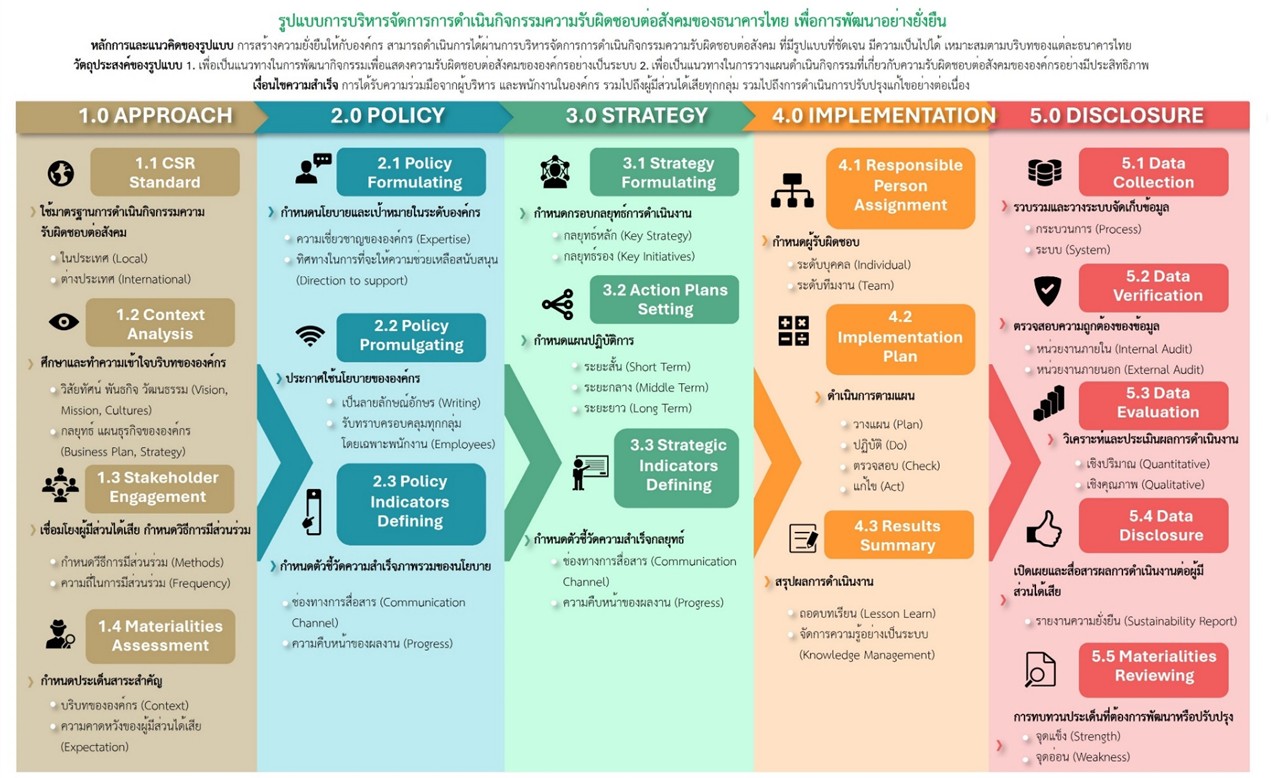Corporate Social Responsibility Activities Management Model of Thai Bank for Sustainable Development
Main Article Content
Abstract
The purposes of this research were: 1) to study the implementation of corporate social responsibility (CSR) activities of Thai banks, 2) to create and develop a management model for the implementation of CSR activities by Thai banks aimed at sustainable development, and (3) to evaluate the management model for the implementation of CSR activities by Thai banks for sustainable development using the Ethnographic Delphi Future Research (EDFR) technique, and the process consists of four steps: 1) Expert Selection Step: This involves 17 experts, including bank executives and employees. 2) Expert Interview Step (EDFR Round 1): Using semi-structured interview guides as the research instrument. 3) Expert Opinion Survey Step (EDFR Round 2): Using structured interviews as the research instrument. 4) Final Step: Writing the report on the results. The findings appear according to the research results below.
The results revealed that:
1. The implementation of corporate social responsibility (CSR) activities by Thai banks, including: 1) Educational activities. 2) Economic development activities. 3) Religious, sports, and cultural activities. 4) Social welfare activities. 5) Environmental activities. 6) Public health activities. 7) Disaster relief activities.
2. The management model for implementing corporate social responsibility (CSR) activities by Thai banks for sustainable development includes: 1) Model name. 2) Principles and concept of the model. 3) Objectives of the model. 4) Factors of the model: 1. Operational guidelines. 2. Organizational policy formulation. 3. Strategy formulation. 4. Implementation of CSR activities. 5. Information disclosure. 5) Conditions for success.
3. The results of the evaluation of the management model for implementing corporate social responsibility (CSR) activities by Thai banks for sustainable development, developed by the researcher, indicate that experts found the model to be feasible, appropriate, accurate, and practically applicable.
Article Details

This work is licensed under a Creative Commons Attribution-NonCommercial-NoDerivatives 4.0 International License.
เพื่อให้เป็นไปตามกฎหมายลิขสิทธิ์ ผู้นิพนธ์ทุกท่านต้องลงลายมือชื่อในแบบฟอร์มใบมอบลิขสิทธิ์บทความ ให้แก่วารสารฯ พร้อมกับบทความต้นฉบับที่ได้แก้ไขครั้งสุดท้าย นอกจากนี้ ผู้นิพนธ์ทุกท่านต้องยืนยันว่าบทความ ต้นฉบับที่ส่งมาตีพิมพ์นั้น ได้ส่งมาตีพิมพ์เฉพาะในวารสาร วิชาการธรรม ทรรศน์ เพียงแห่งเดียวเท่านั้น หากมีการใช้ ภาพหรือตารางของผู้นิพนธ์อื่นที่ปรากฏในสิ่งตีพิมพ์อื่นมาแล้ว ผู้นิพนธ์ต้องขออนุญาตเจ้าของลิขสิทธิ์ก่อน พร้อมทั้ง แสดงหนังสือที่ได้รับการยินยอมต่อบรรณาธิการ ก่อนที่บทความจะได้รับการตีพิมพ์References
นิภา วิริยะพัฒน์. (2552). ก้าวทันกระแส CSR: ความพร้อมสู่มาตรฐาน ISO26000. วารสารวิชาการมหาวิทยาลัยหอการค้าไทย, 29(3), 193-205.
บรินดา สัณหฉวี. (2559). ความรับผิดชอบต่อสังคมขององค์กรในอุตสาหกรรมส่งออกอาหารไทยไปตลาดสหภาพยุโรป. วารสารเซนต์จอห์น, 19(24), 142-143.
เพ็ญประภา วงศ์ทอง และศศิพรรณ บิลมาโนชญ์. (2560). การรับรู้ข่าวสารและการมีส่วนร่วมในกิจกรรมองค์กรเพื่อสังคม (CSR) ของพนักงานธนาคารไทยพาณิชย์จำกัด (มหาชน). วารสารนิเทศสยามปริทัศน์, 15(18), 107-120.
มนตรี ไทรโรจน์รุ่ง. (2565). โมเดลความรับผิดชอบต่อสังคมขององค์กรที่ส่งผลต่อประสิทธิภาพทางการเงินของธนาคารพาณิชย์ในประเทศไทย. วารสารสวนสุนันทาวิชาการและวิจัย, 16(2), 78-90. https://so05.tci-thaijo.org/index.php/ssajournal/article/view/258118
วิโรจน์ สารรัตนะ. (2555). แนวคิด ทฤษฎี และประเด็นเพื่อการบริหารทางการศึกษา. (พิมพ์ครั้งที่ 8). กรุงเทพฯ: ทิพยวิสุทธิ์.
สถาบันธุรกิจเพื่อสังคม. (2556). ความรับผิดชอบต่อสังคมเพื่อการพัฒนาที่ยั่งยืน. กรุงเทพฯ: สถาบันธุรกิจเพื่อสังคมตลาดหลักทรัพย์แห่งประเทศไทย.
สานิตย์ หนูนิล, วิโรจน์ เจษฎาลักษณ์ และจันทนา แสนสุข. (2560). ปัจจัยเชิงสาเหตุและผลลัพธ์ของความรับผิดชอบต่อสังคมเชิงกลยุทธ์: การศึกษาเชิงประจักษ์ธุรกิจโรงแรมในประเทสไทย. จุฬาลงกรณ์ธุรกิจปริทัศน์, 39(153), 59-84. https://so01.tci-thaijo.org/index.php/CBSReview/article/view/108118/85568
สุมินทร เบ้าธรรม, โสภิดา สัมปัตติกร, ฐานิตย์ เกษร, ชนันทร สวนดอกไม้, ธนพิมพ์ ชุมกาแสง และรุ่งทิวา เหระวัน. (2563). กิจกรรมเพื่อสังคมของบริษัทจดทะเบียนในตลาดหลักทรัพย์แห่งประเทศไทย. วารสารวิทยาการจัดการ มหาวิทยาลัยราชภัฏอุดรธานี, 2(3), 55-66. https://so08.tci-thaijo.org/index.php/MSJournal/article/view/3544/2577
สุรมน ไทยเกษม. (2560). องค์ประกอบของการแสดงความรับผิดชอบต่อสังคมของธนาคารพาณิชย์ในประเทศไทย. วารสารสมาคมนักวิจัย, 22(2), 242-251. https://so04.tci-thaijo.org/index.php/jar/article/view/243064/165127
องค์การตลาด กระทรวงมหาดไทย. (2564). แผนแม่บทความรับผิดชอบต่อสังคมและสิ่งแวดล้อม ระยะ 5 ปี (พ.ศ. 2564-2568). กรุงเทพฯ: กระทรวงมหาดไทย.
อนันตชัย ยูรประถม. (2550). CSR จากแนวคิดสู่วิธีการปฏิบัติ. เข้าถึงได้จาก http://www.tpconsult.co.th/news/CSR.pdf
อุไรรัตน์ อภิวัฒนกุล และจินตวีร์ เกษมศุข. (2565). รูปแบบกิจกรรมความรับผิดชอบสังคมกับความยั่งยืนของธุรกิจกรณีศึกษา บมจ. ทรู คอร์ปอเรชั่น. วารสารปัญญาภิวัฒน์, 14(3), 293-306. https://so05.tci-thaijo.org/index.php/pimjournal/article/view/260829/176655
Adeyemo, S. A., Oyebamiji, F. F., & Alimi, K. O. (2013). An Evaluation of factors Influencing Corporate Social Responsibility in Nigerian Manufacturing Companies. International Journal of Academic Research in Economics and Management Sciences, 2(6), 54-63. http://dx.doi.org/10.6007/IJAREMS/v2-i6/441
Carroll, A. B. (1999). Corporate social responsibility: Evolution of a definitional construct. Business and Society, 38(3), 268-295. https://doi.org/10.1177/000765039903800303
Chapple, W., & Moon, J. (2005). Corporate Social Responsibility (CSR) in Asia: A Seven-Country Study of SCR Web Site Reporting. Business & Society, 44, 415-441. https://doi.org/10.1177/0007650305281658
Freeman, R. E., Parmar, B. L., & Harrison, J. S. (2010). Stakeholder theory: The state of the art. The Academy of Management Annals. Retrieved from https://scholarship.richmond.edu/management-faculty-publications/99/
Godfrey, P. C. (2005). The Relationship between Corporate Philanthropy and Shareholder Wealth: A Risk Management Perspective. Academy of Management Review, 30, 777-798. https://doi.org/10.5465/amr.2005.18378878
Iamandi, I. (2007). Corporate Social Responsibility and Social Responsiveness in a Global Business Environment a Comparative Theoretical Approach. Romanian Economic Journal, 10(23), 3-18.
Kotler, P., & Lee, N. (2005). Corporate Social Responsibility: Doing the Most Good for Your Company and your Cause. New Jersey: John Wiley & Sons.
Lichtenstein, D. R., Drumwright, M. E., & Braig, B. M. (2004). The effects of corporate social responsibility on customer donations to corporate-supported nonprofits. Journal of Marketing, 68, 16-32. https://doi.org/10.1509/jmkg.68.4.16.42726
Luo, X., & Bhattacharya, C. B. (2006). Corporate Social Responsibility, Customer Satisfaction, and Market Value. Journal of Marketing, 70(4), 1-18. https://doi.org/10.1509/jmkg.70.4.1
Maignan, I. S. J., Ferrell, O. C., & Hult, G. T. M. (1999). Corporate citizenship: Cultural antecedents and business benefits. Journal of the Academy of Marketing Science, 27(4), 455-469. https://doi.org/10.1177/0092070399274005
Matten, D., & Crane, A. (2005). Corporate Citizenship: Toward an Extended Theoretical Conceptualization. The Academy of Management Review, 30(1), 166-179. https://doi.org/10.5465/amr.2005.15281448
McWilliams, A., & Siegel, D. (2001). Corporate social responsibility: A theory of the firm perspective. Academy of Management Review, 26(1), 117-127. https://doi.org/10.2307/259398
Owen, C. L., & Scherer, R. F. (1993). Social responsibility and market share. Review of Business, 15(1), 11-16.
Porter, M. E. and Kramer, M. R. (2006). Strategy and Society: The Link between Competitive Advantage and Corporate Social Responsibility. Harvard Business Review, 84(12), 1-15.
Salmones, M. d. M. G. d. l., Crespo, A. H. & Bosque, I. R. d. (2005). Influence of Corporate Social Responsibility on Loyalty and Valuation of Services. Journal of Business Ethics, 61, 369-385. https://doi.org/10.1007/s10551-005-5841-2
Stanwick, P. A., & Stanwick, S. D. (1998). The Relationship between Corporate Social Performance, and Organizational Size, Financial Performance, and Environmental Performance: An Empirical Examination. Journal of Business Ethics, 17, 195-204. https://doi.org/10.1023/A:1005784421547
Stufflebeam, D. L. (2001). Evaluation models. San Francisco, CA: Jossey-Bass.
